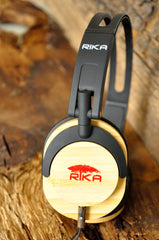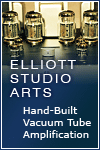I haven't been on here in quite some time but something happened today that I have to tell you about (if there's anyone who's looking..). An acquaintance of mine from church told me about a new venture he's embarked upon. He and his friend found that the market for quality headphones that the younger generation could afford was seriously lacking. So they decided to do something about it, namely, start their own headphone manufacturing company. Right up my alley! He brought over a pair for me to audition on my tube gear and let me just say that I was very impressed. They have 3 models currently; ear-buds (in ear type) called 'The Olympia', a smaller over the ear called 'The Shasta' and a larger over the ear set called 'The Teton'. Now the thing that sets these headphones apart from their immediate competition is the fact that they are made of wood. The ones I listened to were the Shasta, which have a bamboo body. I have Sennheiser HD448's as a reference and the Shasta's sounded very close. Excellent bass, both in quantity and quality, the mids were clear and the highs were a shade brighter than the HD448's, which isn't a bad thing. The overall build quality was high, especially for the price point. The cable if OFC and has the same rubbery jacket that my Sennheiser's have. Another cool aspect to these phones is that the cables unplug from the cans; there's a standard 1/8" mono jack on each ear cup and the cable is terminated with 1/8" gold connectors. One could easily DIY some great headphone cables! Not that the stock ones are lacking in any respect. Another feature is that they fold up, and the quality of the plastic is really nice, with the soft rubbery touch found in many automotive interiors these days.
 Here's the one's I looked at. They're quite handsome for $55.00! I can't wait to hear the Tetons!
Here's the one's I looked at. They're quite handsome for $55.00! I can't wait to hear the Tetons!
Here's a link to their website: http://www.rikaheadphones.com/
They're a startup, and are taking pledges on Kickstarter: http://www.kickstarter.com/projects/rikaheadphones/rika-headphones-wood-and-bamboo-headphones?ref=live
The price for these cans is almost free considering the quality. Get a pair for yourself and a pair for your teenager's ipod, and start a new generation of people who appreciate good sound, not just a flashy skull logo.










 and high-voltage environment of tube amplifiers, and sounds better. I have repaired some contemporary tube amps that use printed circuit boards and have seen catstophic failure of the board itself where the heat of a power resistor actually burns a hole through it. No way to fix that without replacing the entire board! Printed circuit boards also exhibit small amounts of capacitance between traces and the board material itself is not a very good dielectric, which can smear the sound to a degree. That said, we do use printed circuit boards in non-critical areas, like power supplies and logic circuits.
and high-voltage environment of tube amplifiers, and sounds better. I have repaired some contemporary tube amps that use printed circuit boards and have seen catstophic failure of the board itself where the heat of a power resistor actually burns a hole through it. No way to fix that without replacing the entire board! Printed circuit boards also exhibit small amounts of capacitance between traces and the board material itself is not a very good dielectric, which can smear the sound to a degree. That said, we do use printed circuit boards in non-critical areas, like power supplies and logic circuits.











 Since all my equipment was plugged into a power strip it was a simple install: Plug in the Surgex and plug the power strip into it. I let it cook for a day before I had the opportunity to really evaluate my system with this new change. My first impression was immediate- I put on my vinyl copy of Alan Parsons Project 'Pyramid'; it sounded as it does late at night when the backgrounds are blacker, the highs are more shimmery and pure and the sound is generally more liquid and transparent. But even more so than what I'm accustomed to hearing in those (rare) late night sessions: blacker silence, more transparent, more vivid, more liquid. No fatigue, zero, nada, nyet. The bass tightened up, cymbals sounded more real and brassy, voices more pure. I heard vocal tracks way back in the mix I hadn't heard before. Even the hum in my already quiet phono stage w/ no signal was less.
Since all my equipment was plugged into a power strip it was a simple install: Plug in the Surgex and plug the power strip into it. I let it cook for a day before I had the opportunity to really evaluate my system with this new change. My first impression was immediate- I put on my vinyl copy of Alan Parsons Project 'Pyramid'; it sounded as it does late at night when the backgrounds are blacker, the highs are more shimmery and pure and the sound is generally more liquid and transparent. But even more so than what I'm accustomed to hearing in those (rare) late night sessions: blacker silence, more transparent, more vivid, more liquid. No fatigue, zero, nada, nyet. The bass tightened up, cymbals sounded more real and brassy, voices more pure. I heard vocal tracks way back in the mix I hadn't heard before. Even the hum in my already quiet phono stage w/ no signal was less. 

 Well, it's been a while since I've posted here. I've been working on a preamp that is bound for review. The picture above is the regulator section for the outboard
Well, it's been a while since I've posted here. I've been working on a preamp that is bound for review. The picture above is the regulator section for the outboard 





